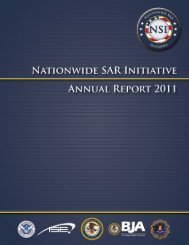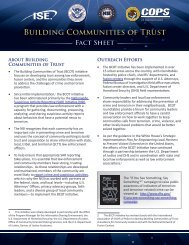NSI Concept of Operations Version 1, December 2008
NSI Concept of Operations Version 1, December 2008
NSI Concept of Operations Version 1, December 2008
You also want an ePaper? Increase the reach of your titles
YUMPU automatically turns print PDFs into web optimized ePapers that Google loves.
<strong>NSI</strong> <strong>Concept</strong> <strong>of</strong> <strong>Operations</strong><br />
4.1 Planning<br />
4.1.1 Produce National Threat Assessments<br />
The <strong>NSI</strong> cycle begins with the production and dissemination <strong>of</strong> information products<br />
about terrorist plans, intentions, and capabilities that are then made available to ISE<br />
participants. These threat assessments—typically but not exclusively, produced by<br />
Federal agencies—may be derived from multiple information sources, take varying<br />
forms, and be issued as classified or unclassified reports. Threat assessments, in turn,<br />
help shape the development <strong>of</strong> local or regional risk assessments by State and major<br />
urban area fusion centers. 27<br />
One important contributor to federally-coordinated threat assessments is the<br />
Interagency Threat Assessment and Coordination Group (ITACG) located at the NCTC.<br />
The ITACG—staffed by personnel from Federal, State, and local agencies—identifies,<br />
reviews, and assesses relevant material <strong>of</strong> interest to SLT entities. It supports the<br />
appropriate dissemination <strong>of</strong> federally-coordinated terrorism information products<br />
through existing websites and distribution channels <strong>of</strong> DOJ, DHS, and other agencies.<br />
Specifically, the ITACG supports the production <strong>of</strong> three types <strong>of</strong> reporting:<br />
1. Alerts, Warnings, and Notifications and updates <strong>of</strong> time-sensitive information<br />
related to terrorism threats to locations within the United States;<br />
2. Situational Awareness Reporting regarding significant events or activities<br />
occurring at the international, national, State, or local level to meet the needs <strong>of</strong><br />
SLT customers; and<br />
3. Terrorism-Related Strategic and Foundational Assessments <strong>of</strong> terrorist threats to<br />
the United States that meet the needs <strong>of</strong> SLT customers.<br />
4.1.2 Conduct Local or Regional Risk Assessments<br />
The threat assessments described in Section 4.1.1 contribute directly to local or<br />
regional risk assessments performed by State and major urban area fusion centers in<br />
collaboration with local DHS representatives, JTTFs, and FIGs. 28 Whereas threat<br />
assessments paint a broad national level picture <strong>of</strong> terrorist plans, intentions, and<br />
capabilities, risk assessments assess the threat in terms <strong>of</strong> specific local or regional<br />
conditions. Accordingly, these regional risk assessments must take into account<br />
vulnerabilities and consequences as well as threats. For example, an indication that a<br />
terrorist group might be planning attacks on passenger rail transport would be <strong>of</strong><br />
significant interest to fusion centers in the Northeast corridor <strong>of</strong> the U.S., but would be<br />
27<br />
Although these threat assessments are discussed here in the context <strong>of</strong> the <strong>NSI</strong> SAR process, they also contribute directly to other<br />
ISE processes as well.<br />
28<br />
In some cases, State Homeland Security Advisors or other <strong>of</strong>ficials may have already performed risk assessments. In these cases,<br />
the assessments would be modified based on the updated threat information if necessary.<br />
17






